Contents
You can make your own winter basil pesto recipe using inexpensive ingredients. Of course, it will differ from the original Italian, but it will also give any second course a unique taste and unforgettable aroma. It is believed that the sauce originates from Genoa and was first described in 1863 by father and son Batta Ratto. But there is evidence that it was prepared in ancient Rome.
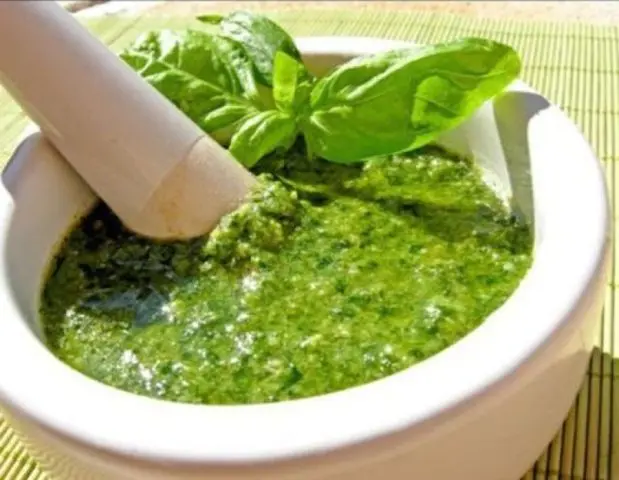
How to make basil pesto
Pesto refers to sauces made from ground ingredients. It is based on Genovese green basil, pine seeds, olive oil, hard sheep’s cheese – parmesan or pecorino. There are many varieties of pesto that differ in additional ingredients. In Italy, the sauce is often made with almonds, fresh and sun-dried tomatoes; in Austria, pumpkin seeds are added. The French love recipes with garlic, the Germans replace basil with wild garlic. In Our Country, it is difficult to find pine (Italian pine) seeds; pine nuts are used instead.
But how can pesto be prepared for the winter? It is unlikely that cheese mixed with butter, nuts and herbs will be stored for a long time, although there will be no problems with the rest of the ingredients under proper conditions. It is simply excluded from the recipe, and added before serving.
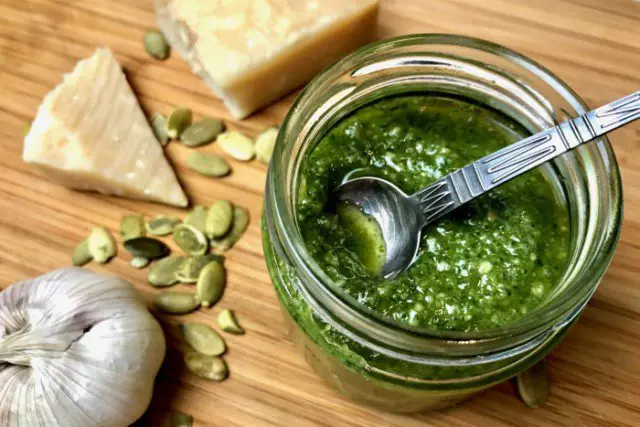
Winter Basil Pesto Recipes
Of course, when harvesting for the winter, basil pesto sauce will be far from the original. But, getting to another country, all national recipes are modified. Locals adapt them to their tastes and familiar products.
Classic winter basil pesto recipe
If there is no parmesan among the ingredients of the sauce, it can be stored for a long time. This winter basil pesto recipe is the closest thing to classic Italian. Before serving, add grated sheep’s cheese to it and mix well. In the economy version, you can use any hard cheese and any basil.
Ingredients:
- basil varieties Genovese – a large bunch;
- pine nuts – 30 g;
- olive oil – 150 ml;
- lemon juice – 10 ml;
- garlic – 1 large clove;
- salt and pepper – to taste.
Preparation:
- Basil is thoroughly washed and rinsed with cold water.
- Squeeze and measure the lemon juice.
- Garlic is freed from scales and cut into several pieces for convenience.
- Prepared ingredients and pine nuts are placed in the blender bowl.
- Grind, add lemon juice and half the olive oil, salt and pepper.
- Beat thoroughly, gradually adding oil (not all).
- Arrange the pesto sauce in small sterile jars.
- A layer of oil is poured on top for better preservation.
- Close the lid and put in the refrigerator.
As you can see in the photo, pesto with basil according to the classic recipe turns out to be a beautiful pistachio color.

purple basil pesto recipe
In fact, little depends on the color of basil for the inexperienced taste of a person who is little familiar with the Mediterranean forge. But a resident of Italy will say that the taste becomes richer and tougher from purple leaves. This pesto will also be sour. But what can you do – if you pour a little lemon juice or neglect it altogether, the sauce will turn out not a beautiful purple color, but an indistinct brown.
Ingredients:
- purple basil – 100 g;
- pistachios – 50 g;
- garlic – 2 tooth;
- lemon juice – 1 tbsp spoon;
- olive oil – 75 ml;
- salt – 0,5 tsp.
In the recipe, the amount of olive oil is indicated only for the sauce. To fill its surface, you should take an additional portion.
Preparation:
- First, grind the pistachios with a blender.
- Then add washed and separated from the twigs basil leaves, cut into several pieces of peeled garlic.
- When the mass becomes homogeneous, add salt, lemon juice and a little oil.
- Continue beating while gradually adding olive oil.
- Spread the finished pesto sauce in sterile jars of a small container.
- Top with a thin layer of olive oil, cover with a lid and put in the refrigerator.
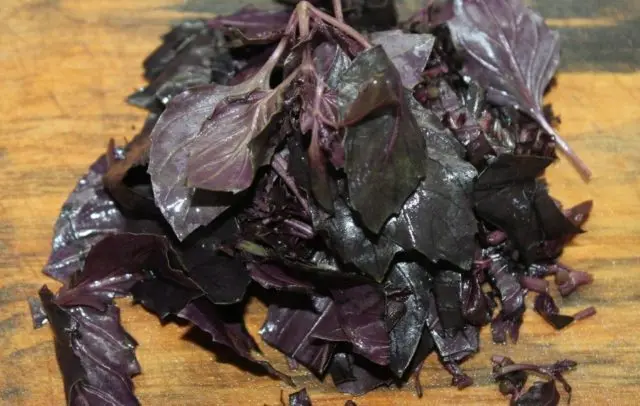
Red basil pesto
For the sauce to be red, it is not enough to use basil with leaves of this color to prepare it. Nuts, butter, other recipe ingredients will make the pesto look ugly. Now, if you add tomatoes, they acidify the sauce and enhance the color.
Ingredients:
- basil with red leaves – 20 g;
- pine nuts – 3 tbsp. spoons;
- sun-dried tomatoes – 100 g;
- garlic – 2 tooth;
- capers – 1 tbsp spoon;
- balsamic vinegar – 1 tbsp. a spoon;
- olive oil – 100 ml;
- salt.
Preparation:
- Wash the basil, rinse, cut off the leaves, put in a blender bowl.
- Add peeled and cut garlic, nuts, sun-dried tomatoes, capers.
- Grind, add salt, capers, pour in balsamic vinegar and olive oil.
- Beat until a homogeneous mass is obtained.
- Sterilize the jar and put the pesto sauce with tomatoes and basil in it.
- Pour a little olive oil on top, close the lid and refrigerate.
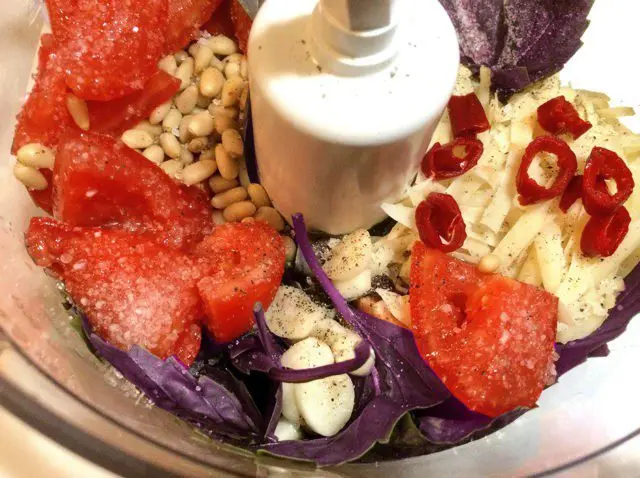
Basil Pesto Sauce with Tomatoes
This sauce is beautiful and delicious. Pepper can be excluded from the recipe.
Ingredients:
- basil – 1 bunch;
- chopped walnuts – 0,3 cups;
- sun-dried tomatoes – 6 pcs.;
- olive oil – 0,3 cups;
- salt – 0,5 tsp;
- garlic – 2 tooth;
- ground pepper – 0,25 tsp.
Preparation:
- Wash the basil, remove the leaves and place in a blender.
- Add peeled and chopped garlic, nuts and tomatoes to greens, chop.
- Pour in pepper and salt.
- Beat until smooth, gradually adding oil.
- Put in a sterile jar.
- Pour a little oil on top, close, put in the refrigerator.
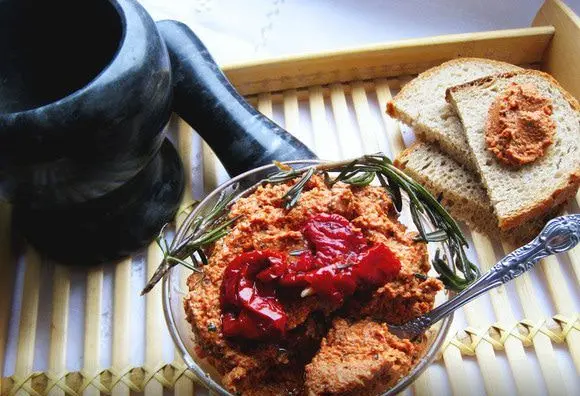
Pesto with walnuts and basil
This sauce is often prepared by residents of regions where it is impossible to get pine seeds, and pine nuts are very expensive. Thanks to the large amount of walnuts, the pesto becomes similar to pkhali, in which basil was used instead of cilantro. Either way, the sauce is delicious.
Ingredients:
- green basil – 100 leaves;
- walnut – 50 g;
- olive oil – 100 ml;
- lemon juice – 1 tbsp spoon;
- mint – 10 leaves;
- Garlic – 1-2 cloves;
- salt.
Preparation:
- Basil and mint are washed, the leaves are cut off.
- Nuts are crushed with a rolling pin so that it is convenient to grind them with a blender.
- Squeezing juice from a lemon.
- The garlic is peeled and cut into several pieces.
- Place the basil, mint, nuts and garlic into the blender bowl and chop.
- Add salt and lemon juice, interrupt, gradually pouring in olive oil.
- Pour the pesto sauce into a sterile jar.
- The top layer is poured with a small amount of oil, closed, put in the refrigerator.
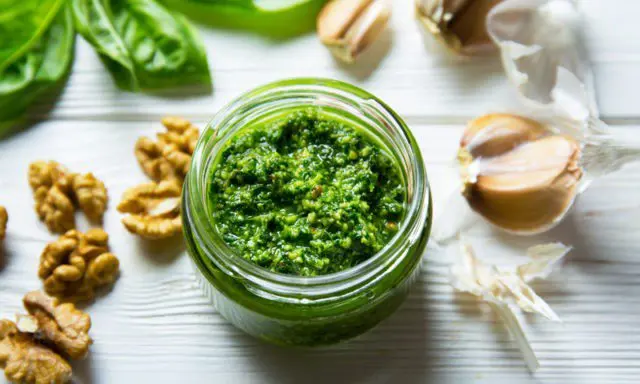
Pesto with parsley and basil
This recipe makes a bright green pesto sauce. Usually it turns out olive, as after processing the leaves of basil grow dull. Here, thanks to parsley juice, the color is preserved.
Since the recipe contains a lot of greens, it will not be stored for long even in the refrigerator. But pesto can be sent to the freezer. There he will lie for several months, even if cheese is added immediately. Such recipes are called cryos and are rarely prepared just because there is never enough space in the freezers.
Ingredients:
- green basil – 2 bunches;
- parsley – 1 bunch;
- pine nuts – 60 g;
- garlic – 4 tooth;
- Parmesan cheese – 40 g;
- padano cheese – 40 g;
- olive oil – 150 g;
- salt.
The relatively small amount of olive oil (compared to other recipes) is due to the pesto being frozen rather than refrigerated. If sheep’s hard cheese is replaced with regular cheese, the sauce will turn out to be completely different, but still tasty.
Preparation:
- Greens are washed thoroughly.
- The leaves of the basil are cut off, the thick stems of parsley are cut off.
- Put in a blender bowl, grind.
- Add peeled garlic, pine nuts, grated cheese.
- Beat, gradually introducing olive oil, until a pasty consistency.
- They are laid out in portions in small vessels or plastic bags, sent to the freezer.
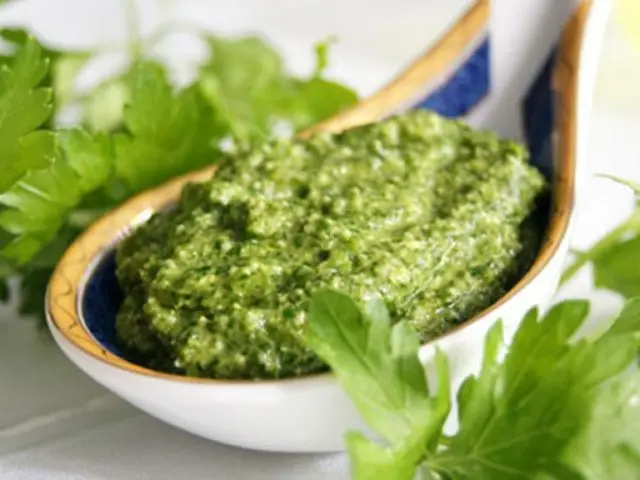
Basil and Arugula Pesto Recipe
It would seem that the sauce prepared with arugula contains too many greens to be stored for a long time. But indau contains mustard oil, which has preservative properties. The taste of pesto with arugula is spicy, with a pronounced pleasant bitterness.
Ingredients:
- basil – 1 bunch;
- arugula – 1 bunch;
- pine nuts – 60 g;
- garlic – 2 tooth;
- olive oil – 150 ml;
- salt.
Preparation:
- Wash the greens, cut off the leaves of the basil.
- Peel the garlic and cut into several pieces.
- Put all the ingredients except salt and olive oil in a blender thicket, chop.
- Add remaining ingredients and beat until smooth.
- Put the pesto sauce in a sterile jar, close, put in the refrigerator.

Helpful Hints and Notes
When preparing pesto for the winter according to various recipes, housewives may need the following information:
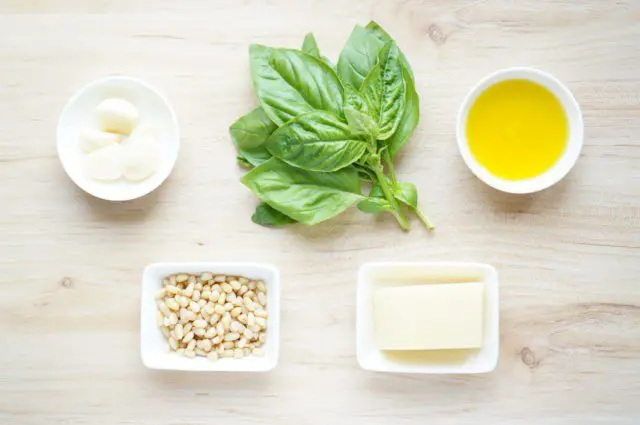
- If you pour a lot of olive oil into the sauce, it will turn out to be liquid, a little – thick.
- The flavor of the pesto is highly dependent on the nuts used in the recipe.
- Cheese is not added to the long-term storage sauce. But it happens that the hostess has prepared a lot of pesto, or accidentally put parmesan in the winter preparation. What to do? Pack into portion bags and put in the freezer.
- With green basil, pesto will have a milder taste and aroma than if you add red or purple leaves.
- To make the winter sauce better stored, add a little more garlic and acid (if it is provided by the recipe) to it than to the usual one.
- To preserve the color in purple basil pesto, it is customary to add lemon juice. To preserve and enhance the red color, the sauce is made with tomatoes.
- The more olive oil, salt and garlic you add to your pesto, the longer it will keep.
- In winter sauce, it is better to add not fresh tomatoes, but dried or tomato paste.
- Only basil leaves can be added to pesto. From the crushed stems, the sauce will lose its delicate texture and will be bitter.
- When sun-dried tomatoes are included in a recipe, it always refers to small cherry tomatoes, not large fruits.
- On a branch of basil of the “correct” size, there are about 10 leaves, each of which weighs about 0,5 g.
- All pesto recipes are approximate and initially take liberties. Here you do not need to measure the ingredients to 1 g or ml, and if you take a few less or more basil leaves, nothing bad will happen.
- Those who like to do everything according to the rules, and have enough time for this, can replace the blender with a mortar and grind the ingredients of the recipes by hand.
- When preparing a large amount of pesto, you can use a meat grinder instead of a blender.
- For a sauce that is supposed to be stored for a long time, you should take only fresh, and not “reanimated” herbs.
- The approximate volume of 50 g of grated hard goat cheese is a glass.
- If the nuts are roasted when making pesto, the taste will change for the better, but the shelf life will be reduced.
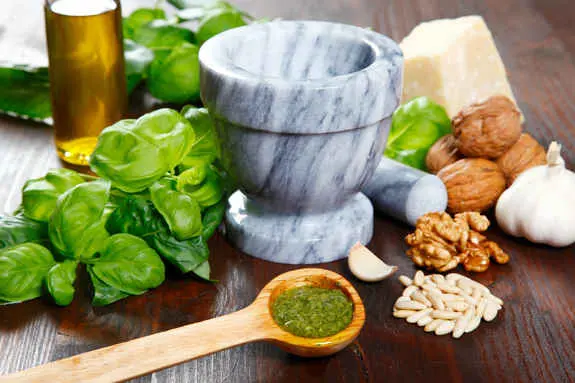
What do you eat basil pesto with?
Pesto is one of the most famous and widespread sauces. The recipe initially allows liberties, it is on the ingredients that not only the consistency of the product depends, but also what it is customary to eat with. But this, as they say, is a matter of taste.
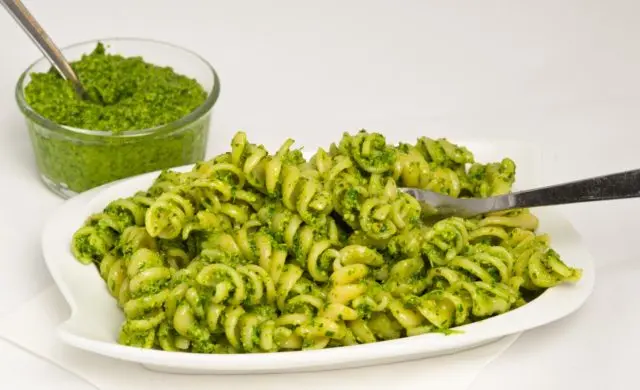
Pesto sauce can be added:
- in any pasta (pasta);
- to cheese slices;
- when baking fish, and it is believed that cod and salmon harmonize best with pesto;
- for making all kinds of sandwiches;
- add pesto to potato, carrot and pumpkin soups;
- for marinating and baking (including grilled) poultry, lamb, pork;
- pesto with tomatoes goes well with eggplant;
- to dry-cured pork;
- mozzarella and tomato pesto is poured over;
- used to prepare other sauces;
- when baking potatoes, mushrooms;
- sauce is an indispensable ingredient in the preparation of minestrone and avocado cream soup.
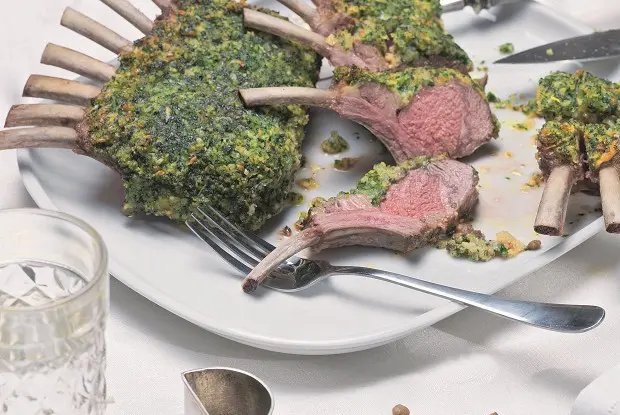
Terms and conditions of storage
It is believed that the “correct” pesto sauce should only be fresh. But Italians and residents of other southern regions can afford such a luxury. In Our Country, for most of the year, greens cost so much that you don’t want any sauce, and you can cook something delicious from grown on the windowsill only for a holiday.
Sometimes there is a statement that pesto with cheese can be stored in the refrigerator for up to 2 weeks. It is not true. The sauce may seem good, but certain chemical processes are already running in it that can harm the body.
Shelf life of pesto with cheese:
- in the refrigerator – 5 days;
- in the freezer – 1 month.
If you prepare the sauce without cheese, arrange it in sterile jars of a small container, and pour olive oil on top, it will be stored in the refrigerator for 2-3 months. But only if the oil layer is preserved! If it dries out or is broken, the pesto will have to be thrown away so as not to harm your health. Therefore, it is advised to pack the sauce in small containers – you will have to eat it for a maximum of 5 days after opening the jar.
Cheese-free pesto will keep in the freezer for up to 6 months. But it should be remembered that you need to eat it in a day. Sauce cannot be re-frozen.
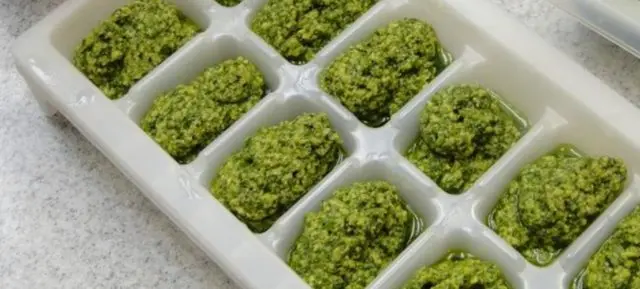
Conclusion
The basil pesto recipe for the winter is easy to prepare, especially since it allows such liberties that you can make both an economical option and an expensive seasoning for the festive table. Of course, after freezing, all products change their taste. But pesto will still be a great addition to boring pasta and diversify other dishes.









